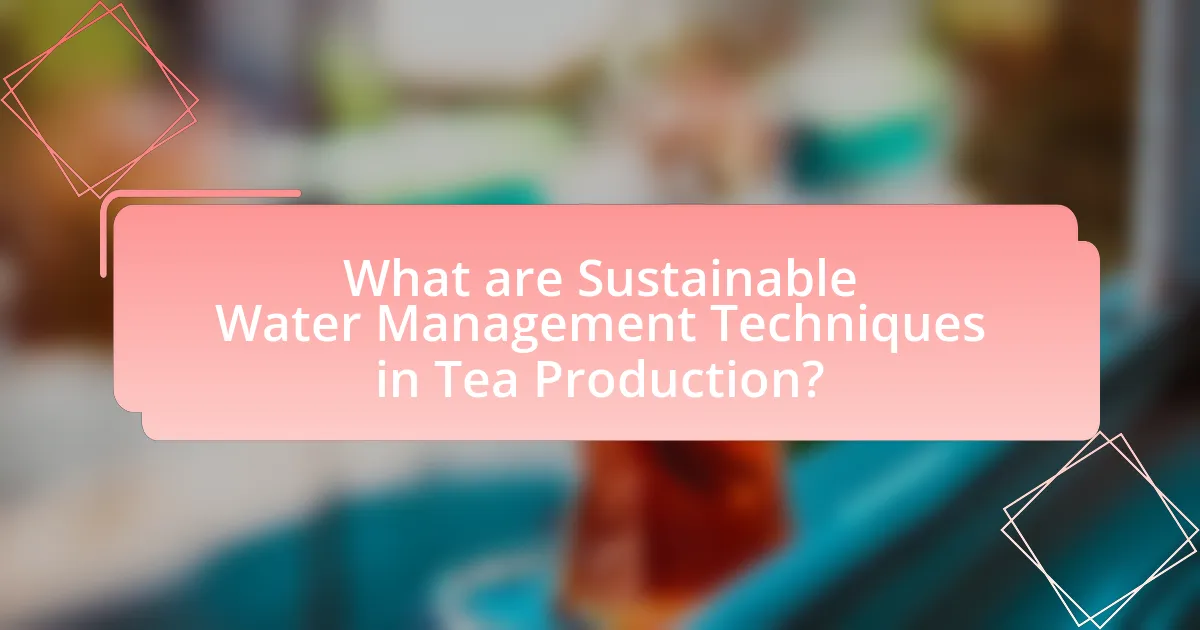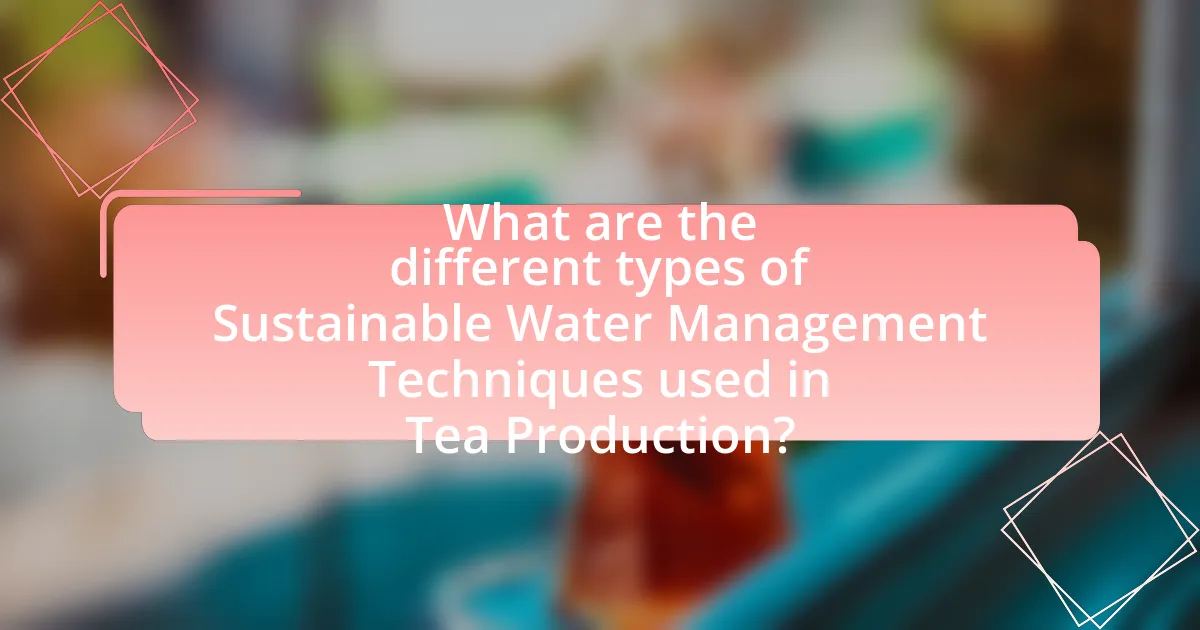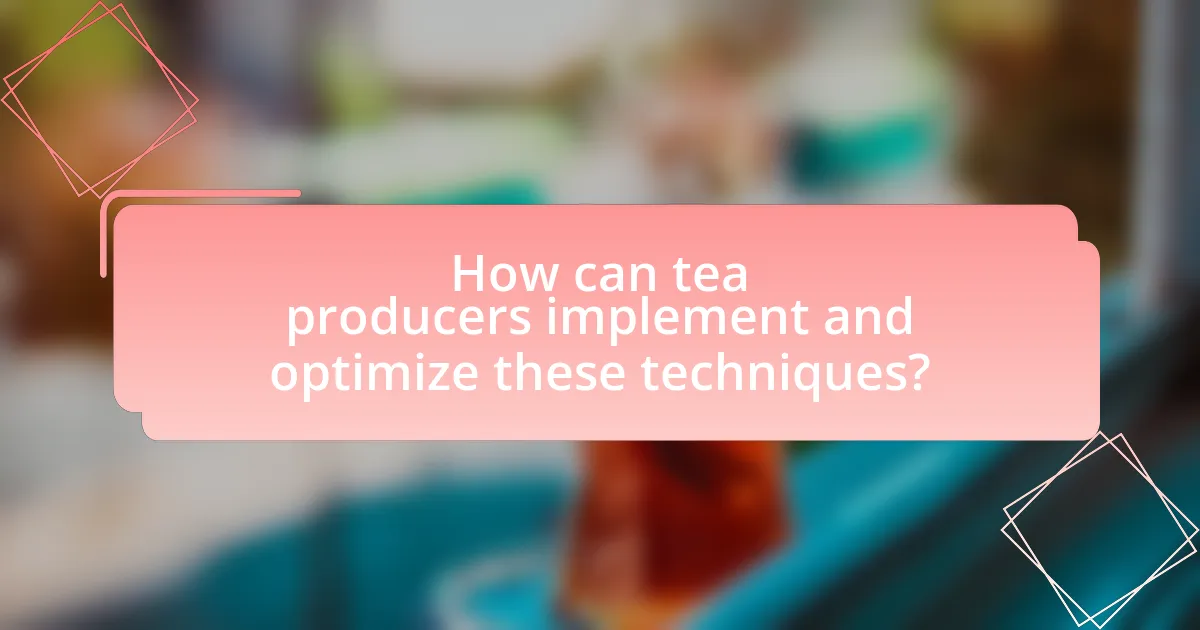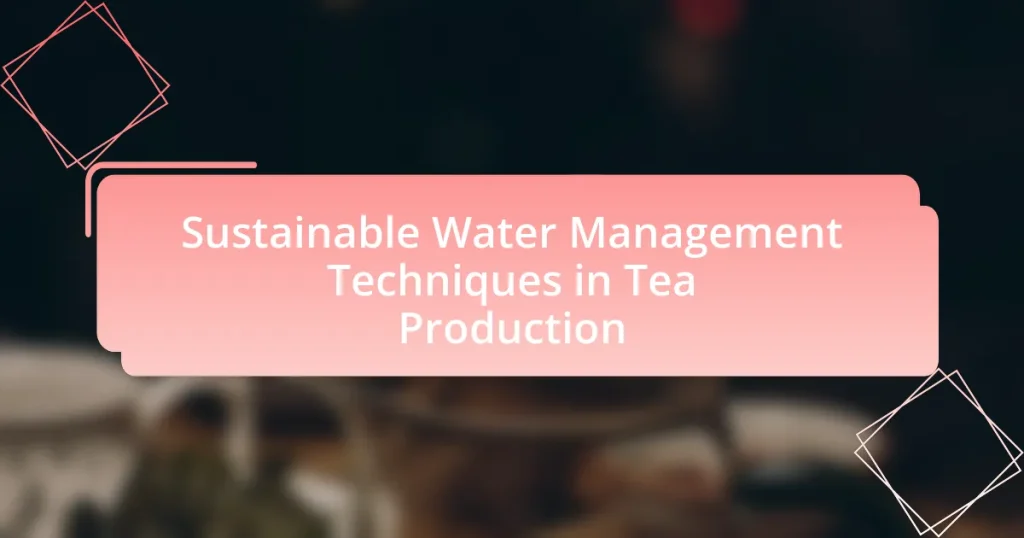Sustainable water management techniques in tea production are essential for optimizing water use and promoting environmental sustainability. Key practices include rainwater harvesting, drip irrigation, and soil moisture management, which collectively enhance water efficiency and reduce reliance on traditional water sources. These techniques not only improve crop yields and quality but also mitigate challenges posed by climate change and water scarcity. The article further explores the principles of sustainable water management, the economic implications of poor practices, and the role of technology in optimizing water usage, providing a comprehensive overview of effective strategies for tea producers.

What are Sustainable Water Management Techniques in Tea Production?
Sustainable water management techniques in tea production include rainwater harvesting, drip irrigation, and soil moisture management. Rainwater harvesting captures and stores rainwater for irrigation, reducing reliance on groundwater and surface water sources. Drip irrigation delivers water directly to the plant roots, minimizing evaporation and runoff, which enhances water efficiency. Soil moisture management involves practices such as mulching and cover cropping to retain soil moisture and improve water infiltration. These techniques collectively contribute to conserving water resources and promoting sustainable agricultural practices in tea cultivation.
How do these techniques contribute to environmental sustainability?
Sustainable water management techniques in tea production contribute to environmental sustainability by optimizing water use and reducing waste. These techniques, such as rainwater harvesting and drip irrigation, minimize water consumption and enhance soil moisture retention, leading to healthier tea plants and reduced reliance on external water sources. For instance, implementing drip irrigation can reduce water usage by up to 60% compared to traditional methods, thereby conserving local water resources and protecting surrounding ecosystems. Additionally, these practices help mitigate soil erosion and promote biodiversity, further supporting sustainable agricultural practices.
What are the key principles of sustainable water management in agriculture?
The key principles of sustainable water management in agriculture include efficient water use, conservation practices, and integrated water resource management. Efficient water use involves adopting technologies and practices that minimize water waste, such as drip irrigation, which can reduce water usage by up to 60% compared to traditional methods. Conservation practices, such as rainwater harvesting and soil moisture management, help maintain water availability and quality. Integrated water resource management emphasizes the coordinated development and management of water, land, and related resources to maximize economic and social welfare without compromising the sustainability of ecosystems. These principles are essential for ensuring long-term agricultural productivity and environmental health.
How do these principles apply specifically to tea production?
Sustainable water management principles apply to tea production by promoting efficient water use, reducing waste, and enhancing water quality. In tea cultivation, practices such as rainwater harvesting and drip irrigation are implemented to optimize water usage, ensuring that plants receive adequate moisture while minimizing evaporation and runoff. For instance, studies have shown that drip irrigation can reduce water consumption by up to 50% compared to traditional methods, thereby conserving water resources. Additionally, integrating cover crops and mulching helps maintain soil moisture and prevent erosion, further supporting sustainable practices in tea production. These techniques not only improve the resilience of tea plants to climate variability but also contribute to the overall sustainability of the agricultural ecosystem.
What challenges do tea producers face in water management?
Tea producers face significant challenges in water management, primarily due to climate variability, water scarcity, and inefficient irrigation practices. Climate variability leads to unpredictable rainfall patterns, which can result in either droughts or excessive rainfall, both of which adversely affect tea crop yields. Water scarcity is exacerbated by increasing competition for water resources from other agricultural sectors and urban development, making it difficult for tea producers to secure adequate water supply. Additionally, many tea producers rely on traditional irrigation methods that are often inefficient, leading to water wastage and reduced availability for tea cultivation. These challenges necessitate the adoption of sustainable water management techniques to ensure the long-term viability of tea production.
How does climate change impact water availability for tea cultivation?
Climate change significantly reduces water availability for tea cultivation by altering precipitation patterns and increasing evaporation rates. As global temperatures rise, regions that traditionally receive adequate rainfall may experience prolonged droughts, leading to water scarcity. For instance, studies indicate that in key tea-producing areas like Assam, India, average rainfall has decreased by approximately 10% over the past few decades, directly impacting irrigation resources. Additionally, higher temperatures can increase the rate of evaporation from soil and water bodies, further diminishing the water supply necessary for tea plants. This combination of reduced rainfall and increased evaporation creates a challenging environment for sustainable tea production.
What are the economic implications of poor water management in tea production?
Poor water management in tea production leads to significant economic implications, including reduced yields and increased production costs. Inefficient water use can result in lower tea quality and quantity, directly impacting farmers’ income and market competitiveness. For instance, studies indicate that inadequate irrigation can decrease tea yields by up to 30%, which translates to substantial financial losses for producers. Additionally, poor water management can lead to soil degradation and increased vulnerability to pests and diseases, further exacerbating economic challenges. Overall, the economic viability of tea production is heavily reliant on effective water management practices.

What are the different types of Sustainable Water Management Techniques used in Tea Production?
Sustainable water management techniques used in tea production include rainwater harvesting, drip irrigation, and soil moisture management. Rainwater harvesting captures and stores rainwater for irrigation, reducing reliance on groundwater and improving water availability during dry periods. Drip irrigation delivers water directly to the plant roots, minimizing water wastage and enhancing efficiency. Soil moisture management involves practices such as mulching and cover cropping to retain soil moisture, thereby reducing the need for additional irrigation. These techniques collectively contribute to more efficient water use and environmental sustainability in tea cultivation.
How does rainwater harvesting work in tea plantations?
Rainwater harvesting in tea plantations involves the collection and storage of rainwater for irrigation and other agricultural uses. This technique typically includes the installation of catchment systems, such as rooftop gutters and storage tanks, which capture rainwater during precipitation events. The collected water is then directed to storage facilities, allowing tea growers to utilize this resource during dry periods, thereby reducing reliance on groundwater and enhancing sustainability. Studies indicate that implementing rainwater harvesting can significantly improve water availability, with some plantations reporting up to a 30% increase in irrigation efficiency.
What are the benefits of implementing rainwater harvesting systems?
Implementing rainwater harvesting systems provides several benefits, including reduced dependency on traditional water sources, cost savings, and improved water quality. These systems capture and store rainwater for agricultural use, which is particularly beneficial in regions with inconsistent rainfall. By utilizing harvested rainwater, tea producers can decrease their reliance on groundwater and municipal water supplies, leading to lower water bills and reduced environmental impact. Additionally, rainwater is often free from contaminants found in other water sources, enhancing the quality of water used for irrigation. Studies indicate that rainwater harvesting can increase water availability by up to 50% in agricultural settings, making it a vital technique for sustainable water management in tea production.
What are the best practices for designing rainwater harvesting systems in tea production?
The best practices for designing rainwater harvesting systems in tea production include selecting appropriate catchment areas, ensuring proper filtration and storage, and implementing efficient distribution methods. Catchment areas should be designed to maximize water collection, utilizing roofs or other surfaces that can direct rainwater into storage systems. Filtration systems must be installed to remove debris and contaminants, ensuring the harvested water is suitable for irrigation. Additionally, distribution methods should be optimized to minimize water loss, employing drip irrigation or other efficient techniques to deliver water directly to the tea plants. These practices enhance water conservation and improve the sustainability of tea production, as evidenced by studies showing that effective rainwater harvesting can significantly reduce reliance on groundwater and improve crop yields.
What role does drip irrigation play in sustainable tea farming?
Drip irrigation plays a crucial role in sustainable tea farming by optimizing water usage and enhancing crop yield. This method delivers water directly to the plant roots, minimizing evaporation and runoff, which is essential in regions facing water scarcity. Research indicates that drip irrigation can reduce water consumption by up to 50% compared to traditional irrigation methods, while also improving tea quality and increasing productivity by 20-30%. These benefits contribute to the overall sustainability of tea farming by conserving water resources and promoting efficient agricultural practices.
How does drip irrigation improve water efficiency in tea cultivation?
Drip irrigation improves water efficiency in tea cultivation by delivering water directly to the root zone of the plants, minimizing evaporation and runoff. This targeted approach ensures that tea plants receive the precise amount of water they need, which can reduce water usage by up to 50% compared to traditional irrigation methods. Studies have shown that drip irrigation not only conserves water but also enhances tea yield and quality, as the consistent moisture levels promote healthier plant growth.
What are the cost implications of adopting drip irrigation in tea production?
Adopting drip irrigation in tea production incurs initial setup costs, which can range from $1,000 to $3,000 per hectare, depending on the system’s complexity and the region. However, these costs are offset by long-term savings in water usage, as drip irrigation can reduce water consumption by up to 50% compared to traditional methods. Additionally, improved water efficiency leads to better crop yields and quality, which can enhance profitability. Studies indicate that farmers can achieve a return on investment within three to five years due to reduced labor and water costs, alongside increased tea production efficiency.

How can tea producers implement and optimize these techniques?
Tea producers can implement and optimize sustainable water management techniques by adopting practices such as rainwater harvesting, drip irrigation, and soil moisture monitoring. Rainwater harvesting allows producers to collect and store rainwater for irrigation, reducing reliance on groundwater and improving water availability during dry periods. Drip irrigation minimizes water wastage by delivering water directly to the plant roots, which can increase efficiency by up to 90% compared to traditional methods. Soil moisture monitoring technologies enable producers to assess soil water levels accurately, allowing for timely irrigation and reducing overwatering. These practices not only conserve water but also enhance crop yield and quality, as evidenced by studies showing that efficient water management can lead to a 20-30% increase in tea production.
What steps should tea producers take to assess their current water management practices?
Tea producers should conduct a comprehensive audit of their current water management practices by evaluating water sources, usage efficiency, and conservation measures. This involves mapping all water sources used in tea cultivation, measuring the volume of water consumed at different stages of production, and analyzing the effectiveness of irrigation systems. Additionally, producers should assess the impact of their water usage on local ecosystems and communities, ensuring compliance with environmental regulations. Data collection on rainfall patterns and water quality is also essential to identify areas for improvement. By implementing these steps, tea producers can enhance sustainability and optimize water resource management.
How can producers identify areas for improvement in water usage?
Producers can identify areas for improvement in water usage by conducting comprehensive water audits that assess current consumption patterns and identify inefficiencies. These audits involve measuring water use at various stages of tea production, analyzing data to pinpoint excessive usage, and comparing it against industry benchmarks. For instance, a study published in the Journal of Cleaner Production found that implementing water audits in agricultural practices can lead to a 20-30% reduction in water usage by highlighting specific areas where water is wasted. By utilizing technologies such as soil moisture sensors and irrigation management systems, producers can further refine their water usage strategies, ensuring that they apply water more efficiently and sustainably.
What tools and technologies can assist in optimizing water management?
Technologies such as precision irrigation systems, soil moisture sensors, and data analytics platforms can significantly optimize water management in tea production. Precision irrigation systems, including drip and sprinkler systems, deliver water directly to the plant roots, minimizing waste and ensuring efficient use of water resources. Soil moisture sensors provide real-time data on soil conditions, allowing farmers to irrigate only when necessary, which can reduce water usage by up to 30%. Data analytics platforms analyze weather patterns and crop needs, enabling informed decision-making regarding irrigation schedules. These technologies collectively enhance water efficiency, promote sustainability, and support the economic viability of tea production.
What are some best practices for sustainable water management in tea production?
Best practices for sustainable water management in tea production include implementing rainwater harvesting systems, utilizing drip irrigation, and adopting soil moisture conservation techniques. Rainwater harvesting captures and stores rainwater for irrigation, reducing reliance on groundwater and surface water sources. Drip irrigation delivers water directly to the plant roots, minimizing evaporation and runoff, which can lead to significant water savings. Soil moisture conservation techniques, such as mulching and cover cropping, enhance soil structure and retain moisture, further optimizing water use. These practices not only improve water efficiency but also contribute to the overall sustainability of tea production by protecting local water resources and reducing environmental impact.
How can tea producers engage with local communities to enhance water management efforts?
Tea producers can engage with local communities to enhance water management efforts by collaborating on sustainable practices and sharing knowledge about water conservation. This engagement can include organizing workshops that educate community members on efficient irrigation techniques and the importance of maintaining local water sources. For instance, studies have shown that participatory approaches, where tea producers involve local stakeholders in decision-making, lead to improved water resource management and increased community awareness. Additionally, establishing partnerships with local organizations can facilitate the implementation of water-saving technologies, benefiting both tea production and the surrounding ecosystem.
What are the long-term benefits of adopting sustainable water management techniques in tea production?
Adopting sustainable water management techniques in tea production leads to improved water efficiency and enhanced crop resilience. These techniques, such as rainwater harvesting and drip irrigation, reduce water waste and ensure that tea plants receive adequate moisture, which is crucial for their growth. Research indicates that implementing these methods can increase yield stability by up to 30% during periods of drought, thereby securing farmers’ livelihoods. Additionally, sustainable practices contribute to the preservation of local ecosystems by minimizing water pollution and maintaining groundwater levels, which supports biodiversity. Overall, these long-term benefits not only enhance agricultural productivity but also promote environmental sustainability in tea production.


